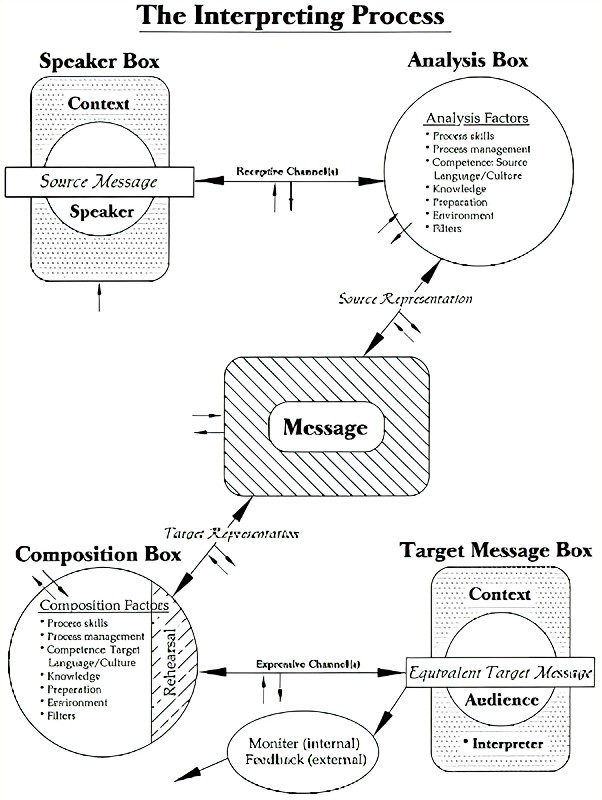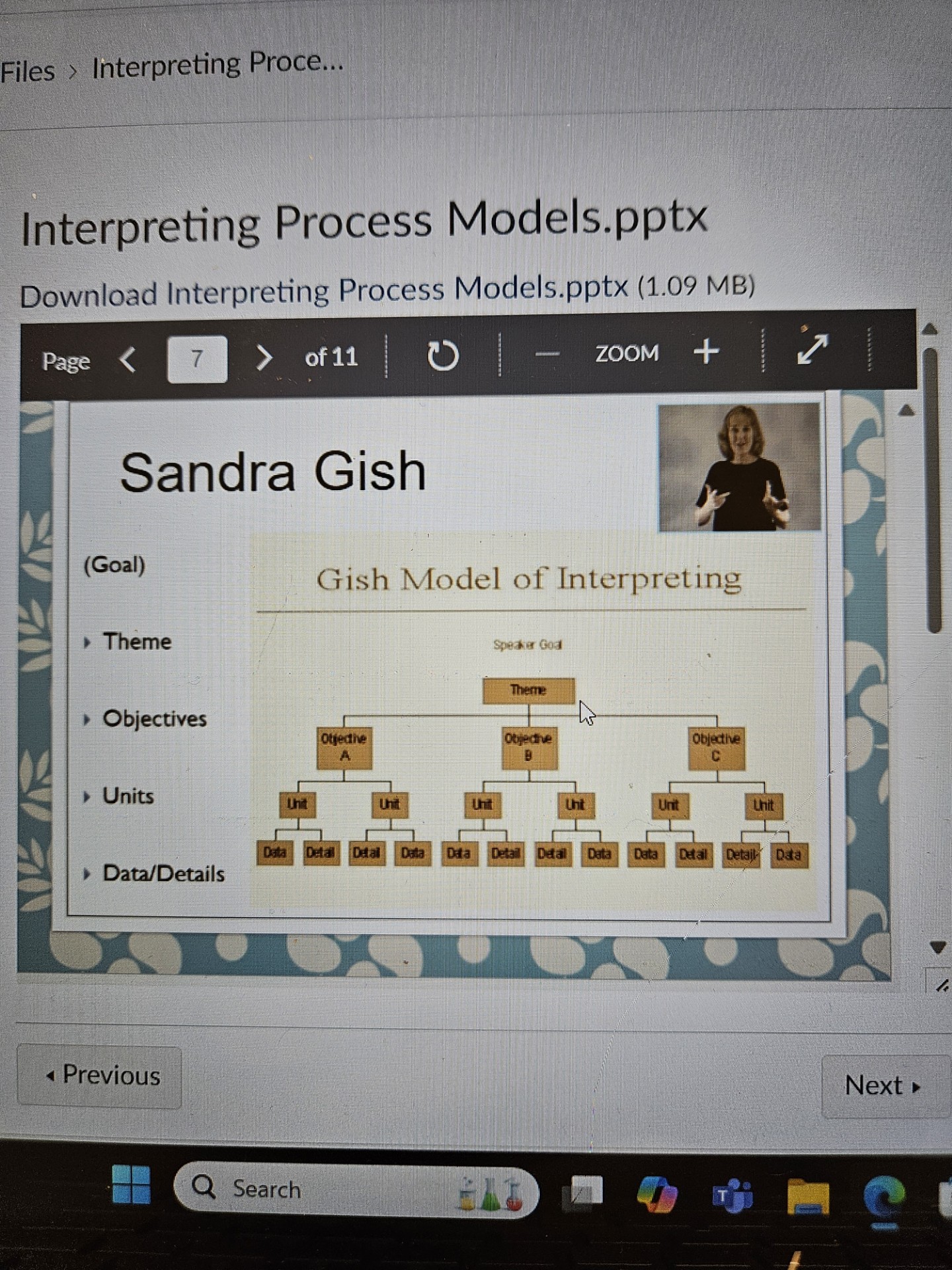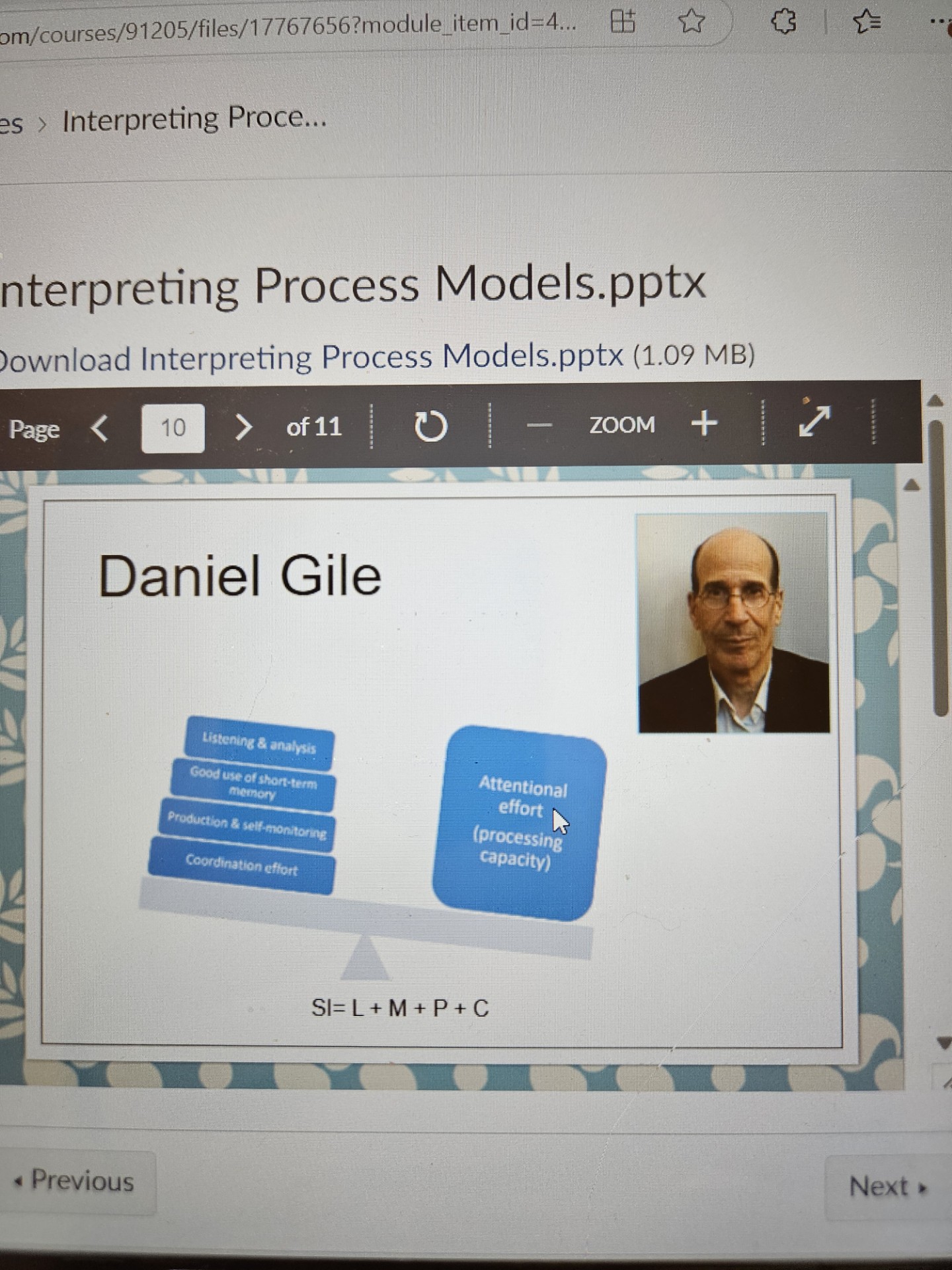Interpreting survey test: Process Models/Chapter 6 and 7 in spiral bound
1/27
There's no tags or description
Looks like no tags are added yet.
Name | Mastery | Learn | Test | Matching | Spaced |
|---|
No study sessions yet.
28 Terms
Betty Colonomos Process Model
believes that you cannot master all of the knowledge and skills required to be an interpreter within a 2year or 4year academic program. Your academic education is a launching pad to a lifetime journey to build greater bilingual and bicultural knowledge as well as interpreting skills in addition to building on the foundation of your formal education.

Sandra Gish Process Model
said it seemed that the “difference between an effective and ineffective interpreting performance often seemed to lie in the use of appropriate pause, connections, and inflections, as well as in the specific grouping of information for presentation.

Dennis Cokely Process Model
concluded that interpreters could minimize the occurrence of errors or miscues in their interpretation by identifying the stage where the miscues occurred and determined the cause of those errors for the interpreter to stop making those types of errors.

Daniel Gile Process Model
work focused on the practice of simultaneous. interpreting in monologic conference settings, where as the models introduced above were applied to dialogic interpreting

Aboriginal(Chapter 6)
Original inhabitants
Acculturation(Chapter 6)
Is a process where two cultures come into contact, which changes one or both cultural groups
Collectivist Norms(Chapter 6)
Are most concerned with the welfare of the group and the group relationships
Colonialism(Chapter 6)
Is a form of domination by controlling group/individuals which demonstrated through the exploration of that group’s culture and language
Deafhood(Chapter 6)
Dr. Paddy Ladd’s (2005) model offers the term deafhood, as a means to share the value systems of deaf people, as a unique people who are “ ‘visuogesturo-tactile’ biological entities, [that] believe they offer a different and positive perspective on what it means to be human.
Ethnicity(Chapter 6)
Refers to the culture, language, history, ect. of people groups
Heritage Speakers(Chapter 6)
Defined as people who excel at compehending their native tongue, but can still stuggle articulat
Heritage Speakers
Defined as people who excel at comprehending their native tongue, but can still struggle articulating themselves through spoken or written words
Indigenous People(Chapter 6)
Defined as people who originally resided in the land but were removed forcibly
Individualism(Chapter 6)
Is the belief that the needs, preferences and desires of the one are stressed over the needs of the whole
minority(chapter 6)
Refers to a small group of people that are often discriminated against in a community, either by society or on a national level because their language, race, beliefs, ect. differ
Race(Chapter 6)
Is defined as the physical characteristics of people, which are considered significant on a social scale
Trilingual Interpreter(Chapter 6)
Possess fluency in three unique and separate languages and culture. They must possess knowledge related to the unique aspects that create distinctions between the cultures as well as the ability to successfully interpret these differences
Cultures and Races(chapter 6)
have aspects that make them different and unique, such as:
Language use
Learning styles and values
Family
Spirituality and religion
Races and Ethnicities(Chapter 6)
there are no biological determinants of races not distictions between these words. These races are commonly recognized in the United States:
Black
Caucasion
Asian
Hispanic/Latinx
Native American
Cultural sharing(Chapter 6)
is how family members pass culture, traditions, experiences, ect. to their children
Acculturation(Chapter 6)
experiences vary depending how the minority culture interacts with the majority culture
Indigenous People(Chapter 6)
identifying characteristics are land and language, which create a sense of community and to lose either hurts and sense of community (Department of Economic and Social Affairs, 2009)
Trilingual Interpreters(Chapter 6
must be able to read and write in all of their languages
Platform(Chapter 7)
means you’re interpreting in front of a large audience, most often in a formal setting where the speaker does most of the talking.
Mirroring(Chapter 7)
The purpose of mirroring is when there is a large number of people attending a gathering, such as a workshop, or a presentation, and member of the audience use American Sign Language
Consecutive(Chapter 7)
This is the most common approach employed by dDeaf interpreters. This interpreting usually has a unique setup - the dDeaf interpreter sits next to the hearing participant and the co-interpreter sits or stands either right next to the dDeaf participant or slightly behind
simultaneous(chapter 7)
mode of interpreting in which the interpreter translates the message from the source language to the target language in real-time
Close-Vision and Tactile(Chapter 7)
Oftentimes, the dDeaf interpreter will be assigned to a DeafBlind client or a low-vision client, in this case, it really is up to the DeafBlind participant and how they like to receive the information. Some like to sit side by side, some like to sit directly across from each other. some prefer one and others prefer two.